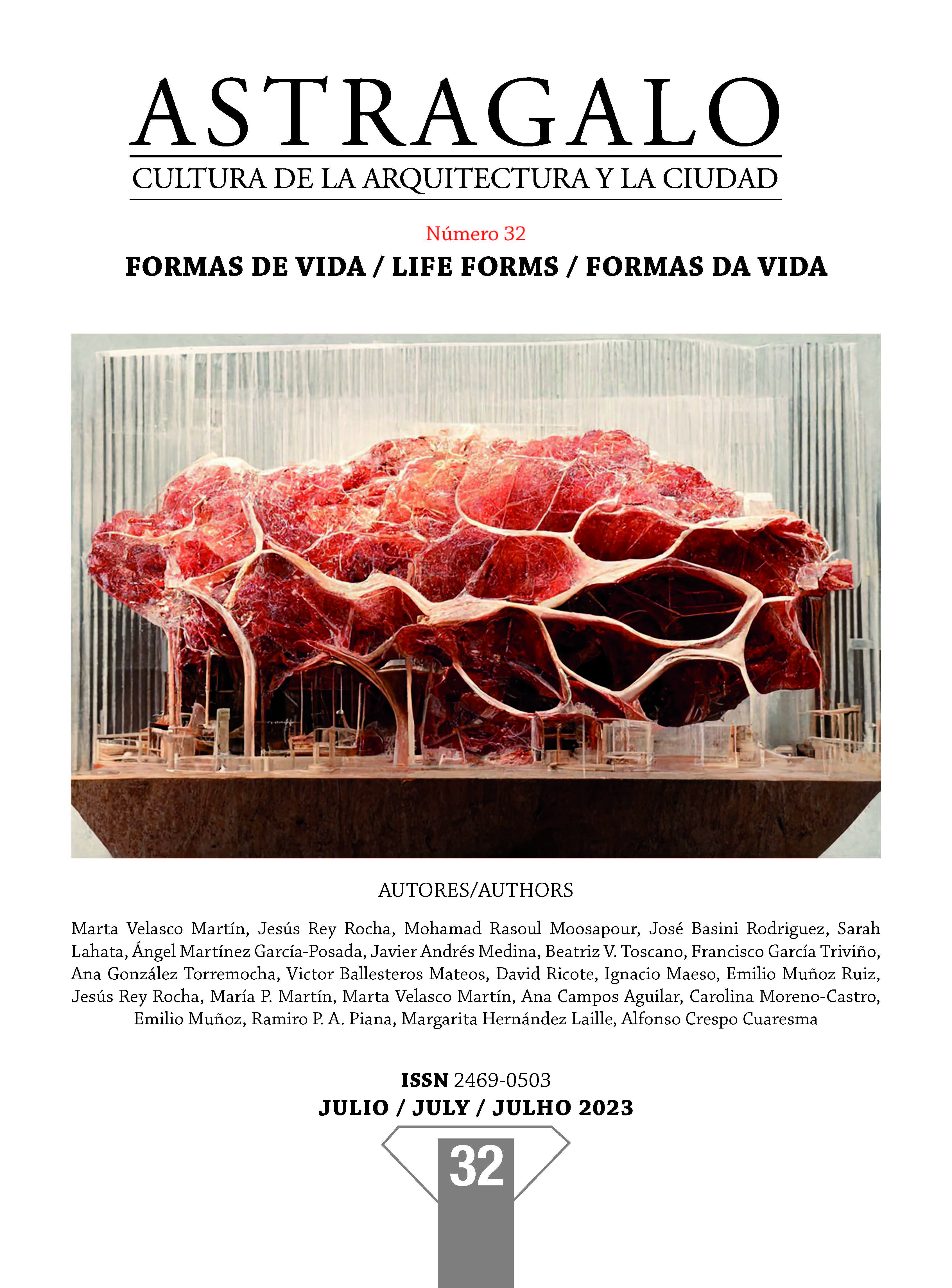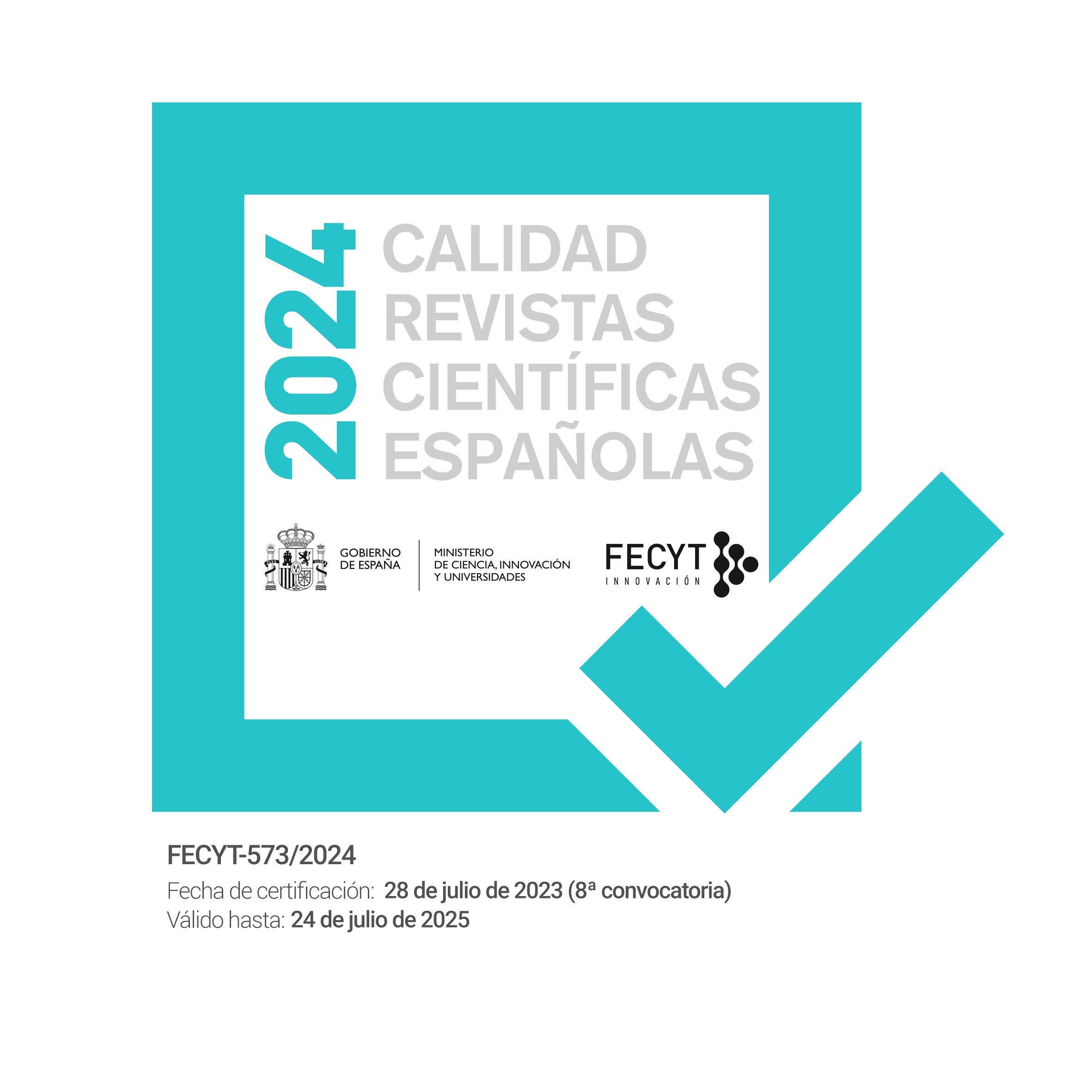Urban Ecosophies. Marseille or the City as a Body without Organs
DOI:
https://doi.org/10.12795/astragalo.2023.i32.07Keywords:
Felix Guattari, urban design, biophilia, brutalism, Marseille, private propertyAbstract
Cities are not only inhabited by humans. In them there has always existed a collaboration or a struggle between human and animal nature, manifested in the continuous drift between two types of urban space: one, the planned space of the city, striated by the organicist axiom of functionality and commodification. The other, is a smooth, spontaneous and disorganized space, produced by the autonomous development of animal life. In the context of the current ecological crisis, the functional city is seen as an agent of displacement and obliteration of animal life. Beyond its predatory and appropriating expansion into the rural realm, urban planning is often haunted by a lack of keys, tools and technologies to accommodate cooperative forms of habitation between humans and animals. The following article proposes the vindication of a new Urban Ecosophy, that is, of a new paradigm of biophilic integration of urban life, capable of effecting a physical and ontological desegregation between human and non-human nature in cities. The root of this segregation will be sought in the project of consolidation of the middle classes after the world war and where the brutalist work of F. Pouillon (1912-1986) in Marseilles (1949) is a pioneer. Starting from the premise of a necessary de-splinttering of post-pandemic urbanism and after the crisis of the middle classes in general (which contemplates a crisis in the centrality of private property for class continuity) and through Felix Guattari's text The Three Ecologies (1989), a new model of urban design of reconciliation between the human and the animal will be advocated.
Downloads
References
Amir, Fahim. 2018. Schwein und Zeit. Tiere, Politik, Revolte. Hamburgo: Nautilus.
Attia, Kadar. 2009. Ghardaia-Le Corbusier. (Internet) http://kaderattia.de/ghardaia-le-corbusier/ (Abril 2023)
Artaud, Antonin. 1947, 2013. Para terminar con el juicio de dios. El teatro de la crueldad. Buenos Aires: Editorial El cuenco de plata.
Barbieri, R. and M. Drancourt. 2018. “Two Thousand Years of Epidemics in Marseille and the Mediterranean Basin”, New Microbes and New Infections, 26: Suppl. 1, 4–S9, doi:10.1016/j.nmni.2018.08.009.
Barr, Rebecca Anne, Sylvie Kleiman-Lafton, and Sophie Vasset (eds). 2018. Bellies, bowels and entrails in the eighteenth century, Seventeenth and Eighteenth Century Studies MUP, Manchester: Manchester Scholarship Online.
Benjamin, Walter. 1972, 1990. Haschisch. Madrid: Taurus.
Beaune, Henri. 1889. Description de la peste à Aix en l'année 1580. e-Médiatheque – SHS
De Botton, Alain. Louis Kahn. Series on Art and Architecture. The School of Life. https://www.youtube.com/watch?v=b99oGua6V20 (Abril 2023)
Byers, Kaylee A. et al. 2019. "Rats about town: A systematic review of rat movement in urban ecosystems." Frontiers in Ecology and Evolution 7: 13.
Cantor, Matthew. 2023. “The miracle that disrupts order’: mathematicians invent new ‘einstein’ shape”. The Guardian, 4 Abril 2023.
Carnell, Hugo. 2022. "Historical and Modern Responses to Plague Epidemics: What Lessons Can Be Drawn from Case Studies in France, the United States and Madagascar?”. Journal of Humanitarian Affairs 4.2: 3-11.
Chapman, Brian. 1953. “Baron Haussmann and the Planning of Paris.” The Town Planning Review. Vol. 24, No. 3, Octubre, 177-192.
Cupers, Kenny. 2014. The Social Project. Housing Postwar France. Minnesota: University of Minnesota Press.
Deuze, Gilles. 1996. Lógica del sentido. Barcelona: Paidós.
Deleuze, Gilles & Guattari, Felix. 1972, 1985. El anti-Edipo : capitalismo y esquizofrenia. Barcelona: Paidós.
Foucault, Michel. 1967, 1984. “Of Other Spaces: Utopias and Heterotopias”. Architecture /Mouvement/ Continuité. Paris, Octubre, 1984. Aquí en la versión en inglés del texto original francés presentado por Foucault en 1967 en una conferencia bajo el título de “Des Espace Autres” por la traducción del francés de Jay Miskowiec.
Foucault, Michel. 2001. „Il faut défendre la société. Cours au Collège de France (1975-1976)“. https://monoskop.org/images/9/99/Foucault_Michel_Il_faut_defendre_la_societe.pdf (Abril 2023).
Fraser, Nancy. 1995. “From Redistribution to Recognition? Dilemmas of Justice in a 'Post-Socialist' Age”. The New Left Review, I/212. Julio/Agosto 1995.
Fraser, Nancy; Honneth, Axel. 2003. Redistribution or recognition?: A political-philosophical exchange. Londres, Nueva York: Verso Books.
Fraser, Nancy. 2022. Cannibal Capitalism. Londres, Nueva York: Verso Books.
Frioux, Stéphane. 2013. Les batailles de l'hygiène; Villes et environnement de Pasteur aux Trente Glorieuses. París: Presses Universitaires de France.
Graham, Stephen & Marvin, Simon. 2001. Splintering Urbanism. Networked Infrastructures, Technological Mobilities and the Urban Condition. Londres, Nueva York: Routledge.
Grammenos, Fanis; Craig, Barry; Pollard, Douglas; Guerrera, Carla. Hippodamus Rides to Radburn. 2008. A New Model for the 21st Century. Journal of urban design. Volume 13 Issue, 163 – 176. Oxfordshire: Taylor & Francis Group.
Gruet, Stéphane. 2013. Fernand Pouillon: Humanité et grandeur d'un habitat pour tous. Toulouse: Editions Poiesis.
Guattari, Felix. 1989. The Three Ecologies. Londres: The Athlone Press.
Guattari, Felix. 1995. Chaosmosis: an ethico-aesthetic paradigm. Indiana: Indiana University Press.
Guattari, Felix. 1996. The Guattari Reader. Gary Genosko (Ed.). Cambridge: Blackwell.
Haraway, Donna. 2003. The Companion Species Manifesto: Dogs, People, and Significant Otherness. Chicago: Prickly Paradigm Press.
Hammarstrand, Nils. 1928. “Hippodamus of Miletus and Greek City Planning”. Journal of the American Institute of Architects, 09/1928, Volume 16, Issue 9. 351.
Heidegger, Martin. 1951, 2015. Construir, habitar, pensar = Bauen, Wohnen, Denken. Edición de Arturo Leyte & Jesús Adrián. Barcelona: La Oficina.
Highmore, Ben. 2017. “The Art of Brutalism: Rescuing Hope from Catastrophe in 1950s Britain”. New Haven & London: Yale university Press.
Horvath, Louise Beltzung and Maicher, Markus. 2016. “Rethinking the City as a Body without Organs”. En Deleuze and the City, 33-45. Edinburgh: Edinburgh University Press.
Jokimäki, Jukka; Kaisanlahti-Jokimäki, Marja-Liisa; Suhonen, Jukka; Clergeau, Philippe; Pautasso, Marco; Fernández-Juricic, Esteban. 2011. “Merging wildlife community ecology with animal behavioral ecology for a better urban landscape planning”. Landscape and Urban Planning, Volume 100, Issue 4, 383-385.
Jordan, D. P. 1992. “THE CITY: Baron Haussmann and Modern Paris”. The American Scholar, 61(1), 99–106. http://www.jstor.org/stable/41211982
Karima, Anouche; Mohamed, Tehami (2018). “Architectural Quality through the Integration of Users' Viewpoints inArchitectural Design: Case Study Pouillon's Diar Es Saada”. Journal of Construction in Developing Countries, 23(1), 149–175, 2018.
Korbi, Marson & Migotto, Andrea. 2019. “Between Rationalization and Political Project: The Existenzminimum from Klein and Teige to Today”. Urban Planning, Volume 4, Issue 3, 299–314.
Leiderer, Annette. 2018. “The Elimination of the German Butcher Dog and the Rise of the Modern Slaughterhouse”. En Animal History in the Modern City: Exploring Liminality. Clemens Wischermann, Aline Steinbrecher & Philip Howell (Eds.), 105–126. Londres: Bloomsbury Academic.
Lindemann, Hans-Eckhard. 1991. Stadt im Quadrat Geschichte und Gegenwart einer einprägsamen Stadtgestalt. Krefeld: Vieweg Verlag.
Lizee, MH., Tatoni, T. & Deschamps-Cottin, M. 2016. “Nested patterns in urban butterfly species assemblages: respective roles of plot management, park layout and landscape features”. Urban Ecosyst 19, 205–224.
Martin, Lewis. Fernand Pouillon: The Future That Didn’t Happen
https://www.declad.com/fernand-pouillon-the-future-that-didnt-happen (8 Abril 2023)
Marx, Karl. 1871. Der Bürgerkrieg in Frankreich. Adresse des Generalrats der Internationalen Arbeiterassoziation (30. Mai 1871). Publicado por primera vez en inglés como panfleto en Londres, junio de 1871. Publicado por primera vez en alemán en Der Volksstaat, Leipzig, 28 de junio-29 de julio de 1871 y como reimpresión separada del Volksstaat, Leipzig 1871. La presente reimpresión corresponde a la última edición en alemán, editada por Friedrich Engels, Berlín 1891. Karl Marx y Friedrich Engels, Werke, Vol.17, 1962, Berlín/DDR, 313-365.
Mazza, Luigi. 2009. “Plan and Constitution: Aristotle's Hippodamus: Towards an 'Ostensive'definition of spatial planning”. Town planning review, Volume 80, Issue 2. 113-141.
Miliutin, Nikolai A. 2021. “The Avoidance of Extremes”. En Sotsgorod: The Problem of Building Socialist Cities. George R. Collins and William Alex (Eds.) https://mitp-arch.mitpress.mit.edu/pub/ci2oe5gb
Mumford, Lewis. 1937. “The Death of the Monument”. Circle: International Survey of Constructive Art, 263-270. Londres: Faber and Faber.
Nequinha, Vicente. ‘Fernand Pouillon – The Modern Master Builder’. CARTHA II/08. https://www.carthamagazine.com/wp-content/uploads/2016/05/08_CARTHA_MANNSCHAFT_NEQUINHA.pdf
Ngo, Anh-Linh & Kempe, André. 2020. “Neue Realismus in der französischen Architektur” - Editorial ARCH+: Neuer Realismus in der französischen Architektur, 240, 1-3.
Nilon, Charles H.; Aronson, Myla F. J.; Cilliers, Sarel S.; Dobbs, Cynnamon; Frazee, Lauren J.; Goddard, Mark A.; O’Neill, Karen M.; Roberts, Debra; Stander, Emilie K.; Werner, Peter; Winter, Marten; Yocom, Ken P. 2017. „Planning for the Future of Urban Biodiversity: A Global Review of City-Scale Initiatives”, BioScience, Volume 67, Issue 4, Abril, 332–342. https://doi.org/10.1093/biosci/bix012
Pasco, Allan. 1997. Sick Heroes. French Society and Literature in the Romantic Age, 1750–1850. Exeter: University of Exeter Press.
Pearson, Chris. 2015. “Beyond ‘resistance’: rethinking nonhuman agency for a ‘more-than-human’ world”. European Review of History: Revue européenne d'histoire, 22:5, 709-725, DOI: 10.1080/13507486.2015.1070122
Pouillon, Fernand. 1964. Les Pierres Sauvages. París: Éditions du Seuil.
Pouillon, Fernand. 1968. Mémoires d'un architecte. París: Éditions du Seuil.
Povinelli, Elisabeth A. 2016. Geontologies. A Requiem to Late Liberalism. Durham: Duke University Press.
Rabinow, Paul. 1995. French Modern Norms and Forms of the Social Environment. Chicago: University of Chicago Press.
Radman, Andrej. 2021. Ecologies of Architecture: Essays on Territorialisation. Edimburgo: Edinburgh University Press.
Sauvage, Henri (Edición de 1994 por Taylor & Francis). The Works of an Architect-Decorator in the Collections del Institut Francais d'Architecture y los Archivos de Paris. Volumen II. Architectural Works, c. 1905-1931. Especialmente los capítulos con el Epígrafe ‘Low Cost Housing’.
Sauvage, Henri. 1911. Six ans de lutte contre le taudis. L’œuvre de la Société Anonyme des Logements Hygiéniques à Bon Marché, París: Archives Henri Sauvage, Centre d'archives d'architectes du XIX Siecle.
Signoli, M. and Tzortzis, S. 2018. « La peste à Marseille et dans le sud-est de la France en 1720–1722 : les épidémies d’Orient de retour en Europe », Cahiers de la Méditerranée, 96, 217–30. doi:10.4000/cdlm.10903.
Sontag, Susan. 1988. Introducción a la edición por la misma autora del Antonin Artaud. Selected Writings. Berkeley: University of California Press.
Spang, Rebecca L. 1992. “‘And They Ate the Zoo’: Relating Gastronomic Exoticism in the Siege of Paris.” MLN, vol. 107, no. 4, 752–73.
Schwartz, Alexandra (2014). „Paris Reborn and Destroyed”. The New Yorker. Marzo 19, 2014.
Tafuri, Manfredo et al. 1971. Socialismo, città, architettura URSS 1917–1937; il contributo degli architetti europei (Collana di Architettura, 3). Roma: Officina Edizioni.
Tinnell, John C. 2012. “Transversalising the Ecological Turn: Four Components of Félix Guattari's Ecosophical Perspective”. The Fibreculture Journal 6: 357-388.
V.V. A.A. Revista Arch+ Número especial dedicado a la Cohabitación entre animals y humanos en el habitat urbano. 247 4/2022.
van den Heuvel, Dirk. 2015. “Between brutalists: The Banham hypothesis and the Smithson way of life”. The Journal of Architecture, 20(2), 293-308.
Voigt, Annette; E. Hauck, Thomas; Hennecke, Stefanie; Reinert, Wiebke. 2020. “Wilde Urbaniten Tier-Mensch-Regime im Habitat Großstadt”. suburban. zeitschrift für kritische stadtforschung. Band 8, Heft ½. 253-262.
Wilson, Elizabeth. 1995. “The Rhetoric of Urban Space”. New Left Review; Vol. 0, Iss. 209, Enero, 146.
Downloads
Published
How to Cite
Issue
Section
License
Copyright (c) 2023 Beatriz V. Toscano

This work is licensed under a Creative Commons Attribution-NonCommercial-ShareAlike 4.0 International License.


















